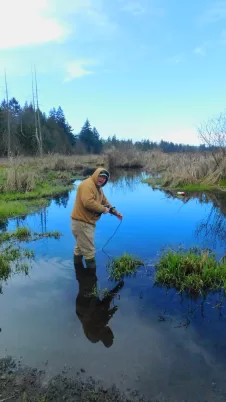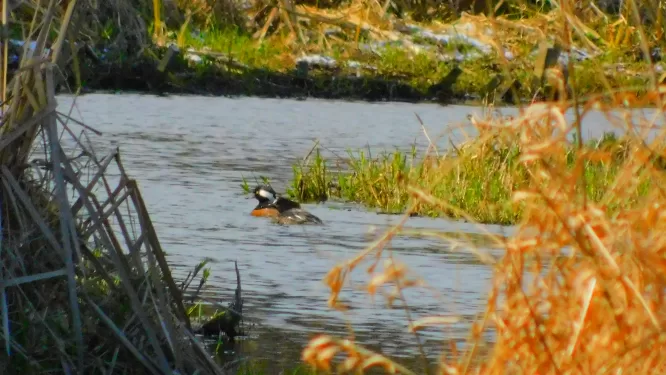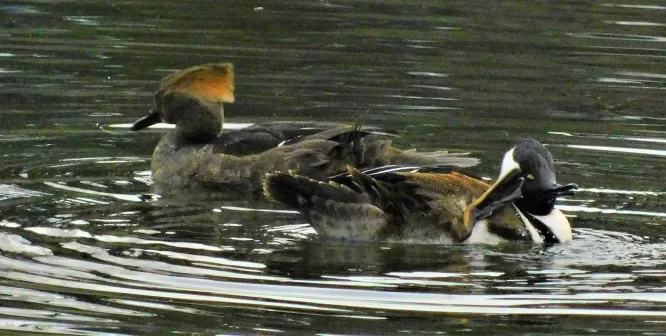Romancer, Merganser: An Uncommon Sea-Duck at the College
by Marcia Wilson
You would think, for a bird that can clock in at 50mph (that’s 80kph), it would be just as speedy at settling down and nesting the new generation of speedsters.
But the Hooded Mergansers down at the college wetlands are still socializing and playing Prom Night with each other. Way back in the ancient month of February we spotted this little couple bobbing about downstream of the pump station, where Dr. Faust takes the majority of his water tests for class.
Below: Not a merganser.

Below, left:

Here we see our paired-up Hooded Mergansers. They are small and swim very fast, but ID is easier on bright days when their colors glow.
What is a merganser anyway? Their Latin name means, ‘crested divers’ because they have large, billowy crests on their heads.
They are highly specialized diving sea ducks. A flock is called a dopping, because dopping is an older UK word for diving (dip, drop, dop, get it?)
Yet, all sea ducks aren’t all mergansers. Common names are:
- Sawbill because of their ‘toothy’ beaks
- Fish Duck because of their preferred diet, and that may be the cause of the third name,
- Trash Duck. Allegedly, if you are really lucky and know what to do and work very hard, they won’t ‘taste terrible’…
Since they are a status (2) for the Pierce County Bird List (that means they are uncommon) we are glad of their presence. They like Flett Creek, but are shy and swift so it is a treat to see them. Our waters are usually full of the small sticklebacks, perch, bluegill, and catfish that means a feast. They are welcome to all the invasive crayfish, frogs, and polliwogs.
Once they pair up, it is anyone’s guess how the young will be raised. HMs do something called ‘egg dumping’ which means…they will use another’s nest to lay eggs if the mood suits them. This isn’t the same as the cuckoo, which kills or weakens the offspring of its foster parents; baby mergansers are precocial (self-sustaining) and feed themselves, so if Mom suddenly finds her brood of 8 has turned into 20+ she isn’t all that upset. It’s not like she has to go hunting for all.
The male’s colors are a gorgeous black, white, and brick-ruddy. The female looks like an orange candle-flame.
They spend a lot of time grooming, preening and bathing.
Pssst…do you think she saw me?

Hilarious, but informative. There were a lot of near-collisions while they tried to look their best. While bird-watching for mergansers, be careful while you’re walking along the shorelines. Mergansers build their nests as close to the water as they can, and they are clever about it. Watch for cavities, and nest boxes put up by thoughtful nature lovers. Above all appreciate the fact that if you manage to get up close, it is because you saw them first! In the past 5 years, the sightings for HMs have seen a slow uptick. Reasons for their increasing presence are unknown, but we hope it continues.